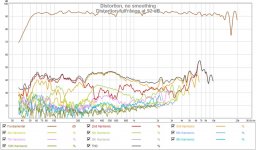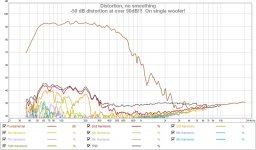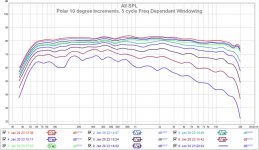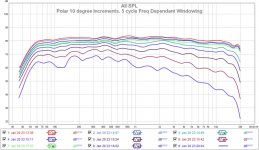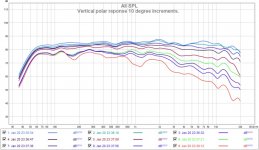
This is at 1m, 90dB and -50dB HD? Is this with a box or blankets?
Absolutely fantastic - nothing else to say. Great work - you can sleep soundly now I think. Imagine what it will sound like integrated with the SB65....
 🙂
🙂
Last edited:
Dudes, I can't stop smiling! The HD of the single woofer is utterly amazing. Lots more measurements to come!
Here's a few full range!
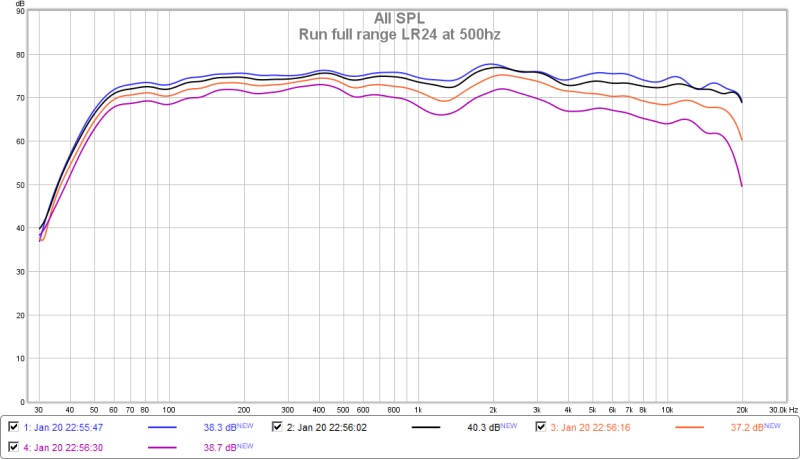
Is this with the SB65 or is your SB23 running up to 20kHz?!
Man you are knocking this one out of the ball park. One comment that has become apparent is that it appears this technology can be made to work with a COTS WG with superior results to a handmade 4 sided conical horn. Furthermore, it appears that this kind of performance using relatively inexpensive drivers may give systems like your Volt 3-way the run for its money. Final comment: who needs stinkin' compression drivers?
Very very encouraging and super results.
😀
Last edited:
X - last measurements of the night:
These are horizontal and vertical polars measured with both the SB65 and SB23 crossed at 500hz standard LR24 crossover with EQ.
I think you will agree - the synergy approach give pretty amazing results - virtually lobe free!
These are horizontal and vertical polars measured with both the SB65 and SB23 crossed at 500hz standard LR24 crossover with EQ.
I think you will agree - the synergy approach give pretty amazing results - virtually lobe free!
Attachments
Only one question comes to mind: did you listen to it?
And what I don't mean by that is asking if the sine sweep sounds any good 😉.
The non smoothed distortion plot FR looks pretty good. I assume you EQ-ed based on the 5 cycle FDW?
And what I don't mean by that is asking if the sine sweep sounds any good 😉.
The non smoothed distortion plot FR looks pretty good. I assume you EQ-ed based on the 5 cycle FDW?
I can tell you based on the graphs that listening to it will sound fantastic. With more time to tweak XO to Harsch quasi transient perfect will improve sound even further. Any speaker with well controlled directivity high sensitivity and low HD like this is guaranteed to sound good. But let's have Bushmeister answer that first hand.
My prediction that the port holes would not mess up the polars was good I think. It actually almost looks better with the holes.
My prediction that the port holes would not mess up the polars was good I think. It actually almost looks better with the holes.
I need to see more than frequency alone to judge though I bet we won't get an answer soon. He won't be able to stop listening to this horn to report back... 🙁
Ha ha - you are right. He is listening to test tracks right now - you know it. 🙂
Although this resembles a synergy, the concept is quite different in that it is a FAST with a full range and a low XO that makes introducing bass injection holes a non critical. Also, a synergy has always used a compression driver which we specifically avoided so that we can cross over low and have less HD. Just clarifying that it's really not the same as a synergy proper.
synergy approach give pretty amazing results - virtually lobe free!
Although this resembles a synergy, the concept is quite different in that it is a FAST with a full range and a low XO that makes introducing bass injection holes a non critical. Also, a synergy has always used a compression driver which we specifically avoided so that we can cross over low and have less HD. Just clarifying that it's really not the same as a synergy proper.
Last edited:
🙄Where'd the narrow 12 db dip at 16k go?
Absorbed by the big band pass holes?
Bushmeister,X - last measurements of the night:
These are horizontal and vertical polars measured with both the SB65 and SB23 crossed at 500hz standard LR24 crossover with EQ.
I think you will agree - the synergy approach give pretty amazing results - virtually lobe free!
Something is wrong with the way you are measuring your polars, there is no way that pattern control can extend evenly all the way down to 40 Hz with a horn the size you are using. Below around 1200 Hz the cabinet should start becoming omnidirectional, the lines should overlay within a dB or so by around 200 Hz.
Also, the low frequency dispersion should be omni in both the vertical or horizontal charts, but the vertical reads tighter.
Can you describe your measurement protocol?
Last edited:
He's running cardoid in a blanket, eq-ed back flat.... 🙂
Or something like that! I was wondering myself, looked like a much bigger horn.
But can Bushmeister stop listening to answer our questions!
Or something like that! I was wondering myself, looked like a much bigger horn.
But can Bushmeister stop listening to answer our questions!
Yes, the blanket EQ'd back to flat is what got me too. May be an interesting approach to get directionality. There is a thread by Onni where he drills a lot of holes in the side of his cabinet (which has a WG tweeter) to basically get the same thing but it doesn't look as smooth and uniform like Bushmeister's.
I wonder how he did the polar measurements with a woofer on one side. Which side did you measure Bushmeister? Ah...dang... he's not hearing me...
If this really works all you need is a fluffy blanket as an enclosure. Instant B&O dispersion control! 😀
If this really works all you need is a fluffy blanket as an enclosure. Instant B&O dispersion control! 😀
Last edited:
Yes, the blanket EQ'd back to flat is what got me too. May be an interesting approach to get directionality. There is a thread by Onni where he drills a lot of holes in the side of his cabinet (which has a WG tweeter) to basically get the same thing but it doesn't look as smooth and uniform like Bushmeister's.
No way a single 10" quasi cardoid digs flat to 40hz. Something's wrong with the measurement procedure or he's working near the event horizon. I've measured 18" woofers down 30db at Fs cardoid an OB.
There's good.......and then there's too good.
Bushmeister,
Something is wrong with the way you are measuring your polars, there is no way that pattern control can extend evenly all the way down to 40 Hz with a horn the size you are using. Below around 1200 Hz the cabinet should start becoming omnidirectional, the lines should overlay within a dB or so by around 200 Hz.
Can you describe your measurement protocol?
OK then I must go to bed! Those are quick measurement taken with a mic stand. I didn't measure from tip of mic to acoustic centre so there is undoubtedly inaccuracies. But this can't account for all of it cause I must only be out by a cm or two tops.
I think wesayso is right, some of this will possibly relate to the fact the woofer is just wrapped in blankets and we are seeing some cardoid behaviour. I thought it was odd too, the main points to note are the single point source behaviour, and excellent CD.
I think the 16000hz dip is still there just smoothed with the freq dependant windowing. It appears in the distortion graph.
Sound? Well it is so hard with a single speaker and minimal bass below 70 hz. But it sound very good.
I will do some better measurements tomorrow and would like to get it phase perfect! Then we'll be ticking most boxes.
I guess we have to wait until he comes back. He may have gone off to bed happy as a clam. 🙂
I agree that a single 8in woofer with 85dB output and -45dB HD is rather special and difficult to realize. Should be perhaps -25dB at best. So we will have to wait for more details of the measurment.
Edit: we cross posted. Ok we get more careful measurements tomorrow. The main thing is the controlled directivity does look excellent.
I agree that a single 8in woofer with 85dB output and -45dB HD is rather special and difficult to realize. Should be perhaps -25dB at best. So we will have to wait for more details of the measurment.
Edit: we cross posted. Ok we get more careful measurements tomorrow. The main thing is the controlled directivity does look excellent.
Last edited:
No way a single 10" quasi cardoid digs flat to 40hz. Something's wrong with the measurement procedure or he's working near the event horizon. I've measured 18" woofers down 30db at Fs cardoid an OB.
There's good.......and then there's too good.
Were your speakers horn loaded with 25% of woofer sd synergy taps? I don't know if this has something to do with it? The is a lot of eq to flatten the response - mostly cutting down the mid hump.
- Home
- Loudspeakers
- Multi-Way
- A Bookshelf Multi-Way Point-Source Horn
